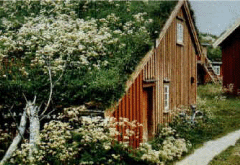

| Definition | ||||
| Green roofs - also known as "eco-roofs," "nature roofs,"or "roof greening systems" - are living, vegetated roofing alternatives to more commonly used impervious roofing materials. There are several different types of green roof system, the suitability of which depends on factors like roof slope, load requirements, climate, type of vegetation used on the roof, and budget. So-called "extensive" green roofs are used for either sloped or flat roofs with a relatively low weight bearing capacity. By contrast, "intensive" green roofs are better suited for only flat surfaces, as well as those intended to bear higher loads. Thus, intensive roofing systems allow for large trees and shrubs, pavers, water systems (ponds, irrigation, etc.), in addition to being functional for human use and recreation. | ||||
| Extensive | ||||
| Extensive green roof systems generally cover most or all of the roof with a thin layer of growing medium and plants. Extensive roofs are lightweight, low-maintenance (once established), and can be retrofitted to most roof systems . Very simple systems consist of succulents, as little as two inches of soil, and a moisture-retaining fabric, all of which are placed on a waterproofing layer and the roof structure. With deeper soil and a more elaborate drainage and irrigation system, extensive green roofs can support grasses, wildflowers, and even small woody shrubs. Extensive roofs are not designed for human occupation and do not support amenities such as patios, walkways, or planters. |  |
|||
Extensive green
roof. www.greenroofs.com |
||||
| Intensive | ||||
| Intensive systems are more substantial ornamental rooftop gardens that may contain up to a few feet of soil, trees and shrubs, patios, water features, and other park-like amenities. These gardens require extensive structural support and are difficult to construct on existing buildings. They also generally require more maintenance, irrigation, and fertilization, and—due to the reduced coverage of plants and soil—offer less environmental benefit. In exchange, they provide garden space for human enjoyment and increase the habitable open space of cities. |  |
|||
Intensive roof
garden www.roof-garden-consultancy.co.uk |
||||